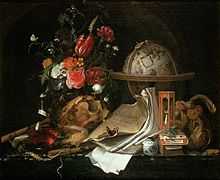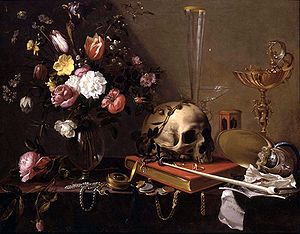Vanitas

In the arts, vanitas is a type of symbolic work of art especially associated with still life painting in Flanders and the Netherlands in the 16th and 17th centuries, though also common in other places and periods. The Latin word means "vanity" and loosely translated corresponds to the meaninglessness of earthly life and the transient nature of all earthly goods and pursuits. As applied to vanitas art, the word is drawn from the biblical book of Ecclesiastes 1:2;12:8.[1] The Vulgate (the Latin translation of the Bible) renders the verse Vanitas vanitatum omnia vanitas.[Eccl. 1:2;12:8] In the King James Version of the Bible this becomes Vanity of vanities; all is vanity. Vanity is used here in its older (especially pre-14th century) sense of "futility".[2]
Themes

Vanitas themes were common in medieval funerary art, with most surviving examples in sculpture. By the 15th century these could be extremely morbid and explicit, reflecting an increased obsession with death and decay also seen in the Ars moriendi, the Danse Macabre, and the overlapping motif of the Memento mori. From the Renaissance such motifs gradually became more indirect and, as the still-life genre became popular, found a home there. Paintings executed in the vanitas style were meant to remind viewers of the transience of life, the futility of pleasure, and the certainty of death. They also provided a moral justification for painting attractive objects.
Motives

Common vanitas symbols include skulls, which are a reminder of the certainty of death; rotten fruit (decay); bubbles (the brevity of life and suddenness of death); smoke, watches, and hourglasses, (the brevity of life); and musical instruments (brevity and the ephemeral nature of life). Fruit, flowers and butterflies can be interpreted in the same way, and a peeled lemon was, like life, attractive to look at but bitter to taste. Art historians debate how much, and how seriously, the vanitas theme is implied in still-life paintings without explicit imagery such as a skull. As in much moralistic genre painting, the enjoyment evoked by the sensuous depiction of the subject is in a certain conflict with the moralistic message. Composition of flowers is a less obvious style of Vanitas by Abraham Mignon in the National Museum in Warsaw. Barely visible amid vivid and perilous nature (snakes, poisonous mushrooms), a bird skeleton is a symbol of vanity and shortness of life.

Vanitas outside visual art
- The first movement in composer Robert Schumann's 5 Pieces in a Folk Style, for Cello and Piano, Op. 102 is entitled Vanitas vanitatum: Mit Humor.
- Vanitas vanitatum is the title of an oratorio written by Italian Baroque composer Giacomo Carissimi (1604/1605 -1674).
- Composer Richard Barrett's 'Vanity,' for Orchestra, is greatly inspired by this movement.
Vanitas in modern times
- C. Allan Gilbert, All Is Vanity, drawing, 1892
- Jana Sterbak, Vanitas: Flesh Dress for an Albino Anorectic, artwork, 1987
- Alexander de Cadenet, Skull Portraits, various subjects, 1996 – present
- Damien Hirst, For the Love of God, sculpture (A diamond skull), 2007
- Vanitas
-
Vanitas Still Life with Self-Portrait, Pieter Claesz, 1628
-

Vanitas painting, self-portrait, most probably by Clara Peeters
-
_by_Edward_Collier.jpg)
Vanitas by Edward Collier
-

Vanitas-Still Life, Maria van Oosterwijck (1630–1693)
-

Vanitas, by Abraham Mignon
-

Vanitas with bust, Johann de Cordua (1630–1702)
-

Vanitas Still-Life by Evert Collier,
-
Adriaen van Utrecht - Vanitas, composition with flowers and skull
See also
- 15 minutes of fame – modern phrase on fleeting vanity
- Emptiness
- Memento mori
- Sic transit gloria mundi
- Ubi sunt
- Tempus fugit
References
- ↑ Esaak, Shelley. "vanitas painting". About.com. Retrieved March 30, 2012.
- ↑ Oxford English Dictionary, on vanity
External links
| Wikimedia Commons has media related to Vanitas. |
| Look up vanitas in Wiktionary, the free dictionary. |
- Vanitas in contemporary art An exhibition at the Virginia Museum of Fine Arts
- Vanitas in the London National Gallery
- Vanités An exhibition at Musée Maillol, Paris
- vanitas (art) - Encyclopædia Britannica

